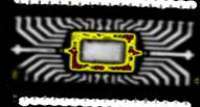Solderability Testing
The solderability test evaluates the ability of electronic component's terminations to be wetted and to produce a suitable fillet when coated in tin-lead eutectic or lead-free solder. This resistance to soldering heat test is intended to confirm that semiconductor components are capable of withstanding the elevated temperatures and thermal shocks associated with hot solder attachment. Steam aging is an optional preconditioning step which degrades the termination finish in order to provide a guard band against marginal finishes or to simulate package storage. These procedures will test whether the packaging materials and processes used during the manufacturing operation produce a component that can be successfully joined to another surface using lead (Pb) containing or Pb-free solder for the attachment.

Module showing poor solder wetting on pads

Although this device is still electrically sound, it has been damaged by solder heat and shows delamination at the wire bonds, detectable only by acoustic microscopy

Good wetting on pins
Typical applications
Compliance to
JESD22-B102E
MIL-STD-883 method 2003.8
MIL-STD-750 method 2026.11
MIL-STD-750 method 2031.3
Telcordia GR468core.002
Failure analysis
Reliability analysis
Equipment
Reflow station
Solder pot
High temperature oven
Steam aging
Optical microscopy
Acoustic microscopy
